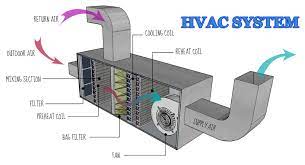HVAC:
Abbreviation of the initial letters 'Heating, Ventilating and Air Conditioning', which refers to the set of technologies related to "Heating, Ventilation and Air Conditioning", which includes technologies related to creating comfort through ventilation and creating comfortable temperature conditions for the indoor environments of the building. The design of HVAC systems is one of the main subgroups of mechanical engineering and is based on the principles of thermodynamics, fluid mechanics and heat transfer.
Sometimes the discussion of refrigeration is added to it and its name is expressed as HVACR or HVAC&R, even in some cases the discussion of ventilation is removed from it and it is called HACR is also used. HVAC plays an important role in the design of medium to large office and industrial buildings such as skyscrapers and marine environments such as aquariums, where environmental safety and health are subject to changes in humidity and temperature.
History:
The foundation of the heating, ventilation and air conditioning industry was laid by the inventions and discoveries of people such as Michael Faraday, Willis Carrier, Reubentrain, James Jewell, William Rankin and Nicolas Saadi Carnot.
Background and purpose:
The invention of devices related to HVAC systems began with the beginning of the industrial revolution, using new methods of modernization, achieving higher productivity and creating control systems by various inventors and companies around the world. The connection of the three factors of heating, ventilation and air conditioning provided thermal comfort in the buildings, suitable air quality inside the buildings and appropriate costs related to the installation, commissioning and maintenance of these systems.
These systems perform ventilation by reducing air infiltration and maintaining pressure between connected environments. How air is distributed and collected in environments is known as "air distribution in the environment" system. Global investment in the HVAC industry takes place through creating job opportunities for setting up and maintaining, designing and manufacturing, manufacturing and selling parts, and training and research in these systems.
Heating:
There are different types of standard heating systems. In regions with cold weather, they use central heating for private houses and public buildings. Such systems include a boiler, furnace (torch) or heat pump to heat water, steam or air, all located in a central location such as an engine room in a house or a utility room in a large building.
Ventilation:
Ventilation is a process to control temperature or remove humidity, odor, smoke, heat, dust and bacteria by changing and moving the air of an environment. Ventilation includes the exchange of air between the outside and the inside of the building and the creation of air circulation in it, as well as one of the important factors in maintaining the quality of the air inside the building.
Ventilation in buildings takes place in two ways, mechanical and natural. Ventilation is used to remove unpleasant odors and excessive humidity in such a way that by sending air outside the building and air circulation inside it, the stagnation of air in the environment inside the building is prevented.
air conditioning:
Air conditioning and cooling systems are designed to remove heat. Cold means the absence of heat and all air conditioning systems work according to this important principle. Heat removal can be done through the processes of radiation, convection or refrigeration cycle. An air conditioning system or an independent air conditioning system provides cooling, ventilation and humidity control for a home or building.
 Controller
Controller


